We have developed nanoscale guitar strings with extremely low energy dissipation, using silicon under stress. The exceptional lifetime of these mechanical oscillators makes them perfect tools to sense minuscule forces in their environment, and to explore how quantum mechanics can apply to macroscopic objects.
Views 2150
Reading time 3.5 min
published on Feb 17, 2023
When you tension a guitar string, you change its resonant frequencies and tune the pitch of the notes you can play on it. Similarly, a nanoscale string will perform faster oscillations (in the radiofrequency, megahertz band) by increasing the tension. However, when the aspect ratio of such a tensioned string becomes extreme, with a length of several millimeters and thickness of about 10 nanometers – around 20 layers of atoms stacked vertically, or twice the diameter of a hemoglobin molecule – the mechanical energy loss is dramatically changed, and can be reduced to extremely low levels. Once plucked, the string can keep oscillating millions of times per second for several hours, as quantified by a figure of merit called quality factor (Q), which counts the number of completed oscillation cycles before the string comes to rest.
Our group has demonstrated extremely long mechanical lifetimes in these nanostring devices, using a combination of methods. The strings were tailored with a non-uniform cross-section, inducing a periodic modulation of the mechanical stress along their axis. This modulation acts as a mirror for acoustic waves, trapping waves at a particular frequency in the string center, that decay smoothly towards the string attachment points, a technique named “soft clamping”. Moreover, we used a crystalline material – strained silicon – for the string fabrication, exploiting the exceptional acoustic properties of crystalline materials. High quality resonances in single-crystal bars and rods of sapphire, quartz and silicon have, in fact, been observed since the 1970s, and their exceptional lifetime is largely attributed to their perfect atomic arrangement. In disordered materials, such as glasses, a multitude of alternative atomic arrangements exist, and little work is required to transition between these configurations. Acoustic waves are then damped as their energy is used to make atoms swing between different equilibrium positions. The synthesis of strained silicon was perfected in the microelectronics industry in order to implement high-speed digital transistors, but the material was never used before to realize nanomechanical devices. Finally, our experiments were carried out at cryogenic temperatures around 7 Kelvin – close to the temperature of liquefaction of Helium. In these cryogenic environments, the quality factors surpassed 10 billion, a record value for mechanical resonators. A regular guitar string (played at room temperature) has a quality factor around one to two thousand.
Nanomechanical resonators are commonly embedded in electronic devices as filters or clocks, and as acceleration sensors (accelerometers and gyroscopes). But these nanostrings are suitable for a different kind of application. Their low dissipation rate implies an excellent isolation from environmental disturbances, enabling fundamental investigations of how quantum mechanics applies to macroscopic objects, and tests of theories that seek to explain one of the most profound mysteries of quantum mechanics – the collapse of the wavefunction. Moreover, the extreme quality factors imply an exceptional sensitivity to all sorts of interactions, for example the tiny radiation pressure imparted by a light beam, or the vanishingly small magnetic fields generated by subatomic particles. The crystalline nanostrings could then realize powerful resonant force sensors. In addition, the control of mechanical stress in the strings can influence material properties beyond mechanical dissipation, and may even induce piezoelectricity in silicon, which does not naturally exhibit it. Another example is the stress-enhancement of electron mobility – the velocity at which electrons drift in response to an applied voltage - in silicon electron devices, which led to the adoption of strained silicon in microelectronics.
The temperatures at which we performed the experiments are relatively close to the absolute zero, but by no means the lowest that can be reliably generated in a laboratory: a cryostat called “dilution refrigerator” can sustain a temperature of about 10 milliKelvin, as needed by superconducting quantum computers and exploited in many solid state physics experiments. At such temperatures the mechanical dissipation of crystalline materials drops dramatically, an exciting prospect for future studies and applications of these nanostrings. For example, at cryogenic temperatures their long lifetimes can be exploited in the preparation of very pure quantum mechanical states of a macroscopic object.
Original Article:
Beccari, A., Visani, D. A., Fedorov, S. A., Bereyhi, M. J., Boureau, V., Engelsen, N. J., & Kippenberg, T. J. (2022). Strained crystalline nanomechanical resonators with quality factors above 10 billion. Nature Physics, 18(4), 436–441. https://doi.org/10.1038/s41567-021-01498-4
 Maths, Physics & Chemistry
Maths, Physics & Chemistry



